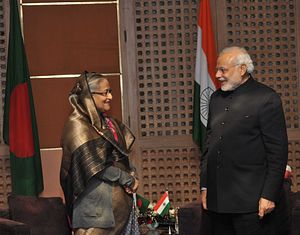While the excuse was the usual one of “interference in internal affairs,” Bangladesh’s perfectly choreographed dovetailing to India’s refusal to attend the Islamabad South Asian Association for Regional Cooperation (SAARC) conference removed any doubt remaining about the relationship between those two neighbors. To put it charitably, Bangladesh under the Sheikh Hasina regime is far closer to the stature of Bhutan and Maldives vis-à-vis India than to, say, pluckier Nepal and prickly Sri Lanka. Under the current Bangladeshi government, the relationship between Dhaka and Delhi has steadily evolved from being that of two theoretically sovereign and equal nations to one of client and vassal in the image of the former communist countries of the Eastern Bloc and the erstwhile USSR. Very similar dynamics are at work as well.
After securing a comfortable victory in Bangladesh’s last free elections in 2008, Hasina quickly moved to ensure – like the Communists in the aftermath of the immediate post-World War II elections in Czechoslovakia, Hungary, Poland, and East Germany – that the painfully built up democratic institutions would never again be used to end her Awami League party’s rule. To that effect, she first broke long the long-held tradition of respecting seniority and appointed her sympathizers to the highest bench of the judiciary. She quickly followed by stacking the technically neutral Election Commission with known cronies and non-entities.
The coup de grace came in 2011 when her parliament, where floor crossing results in cancellation of membership, dutifully got rid of the linchpin of free elections in Bangladesh since 1990: the neutral, election-time caretaker government provision. Not surprisingly, the Supreme Court, by then fully staffed by Hasina’s hand-picked men, was persuaded to give a judgment against the constitutional amendment that had created the caretaker provision. As to how a constitutional Amendment, approved by an internationally supervised popular referendum, could be “unconstitutional” is best left up to the chicanery of judges who have much more in common with the “people’s” judges of the USSR than with those in independent judiciaries.
With the results of any future elections not in doubt and the judiciary suitably tamed, the Awami League government moved decisively to make all dissent very costly, without being so overt as to look askance to European and North American donors. Newspapers and television stations deemed not suitably obeisant to the concept of “chetona” (the Awami ideology that mixes a cult of Hasina’s family with a carefully crafted historical narrative) were shut down. Several prominent newsmen were sent to jail where some still rot without any judicial verdicts against them. New laws on cyber crimes and defamation were hurriedly passed to make any negative reference to members of the ruling family or to the ruling party’s historical narrative a criminal offense.
By the time the next national elections came around in 2014, the results were never in any doubt and the main secular opposition parties saw no point in contesting them. Subsequent elections to local government bodies followed the typical pattern where any opposition figures brave enough to contest or journalists courageous enough to report the irregularities were either beaten up by the Awami League-affiliated Bangladesh Chhatra League (BCL) or roughed up by the police. By early 2015, it was quite clear that the only parts of organized society not controlled by the ruling party were a couple of professional and trade bodies, and some human rights related NGOs. Using organizational elections in the same manner as the national ones, that year the journalists union, the national bar council, and the apex chamber of commerce were all brought under the control of pro-Awami League executives while the last two remaining non-Awami League mayors of major cities were jailed by the regime. All funds coming to NGOs from abroad were required, by new regulations, to be escrowed in government accounts and released only on showing that their educational or human rights work was not a threat to the regime’s sinecure. As if to send a message to the remaining independent journalists, the government orchestrated 88 separate defamation cases against the editor of the premier English newspaper Daily Star. (That the said editor had long been a vocal proponent of the Awami League narrative was not enough to balance against his occasional critique of the regime’s election-time hijinks.)
Bangladesh’s second experiment with pluralist democracy, which began in 1990, is dead. Yet Hasina knows her country and its people well enough to realize how volatile 160 million Bengalis in a 56,000 square mile parcel of land can be. In the absence of any electoral legitimacy, her autocracy is undergirded by the troika of formal security services, which have become very adept at making key dissenters and their family members “disappear”; BCL, which regularly uses street violence to break up any attempts at non-Awami League rallies and processions; and the benevolence of the Narendra Modi government in India. The most important of this troika is, of course, the last one mentioned: with the Obama administration having subcontracted most of its South Asia policy to New Delhi, the mandarins at South Block are both the sword and the shield of the Hasina regime.
For Dhaka to have a foreign policy different than its patron in Delhi would have been a surprise. By meekly following India’s lead in pulling out of the now-postponed SAARC Summit, Bangladesh triggered no surprise.
Esam Sohail is an educational research analyst and college lecturer of social sciences who regularly contributes opinion pieces to the Bangladeshi press. He writes from Kansas, USA.

































